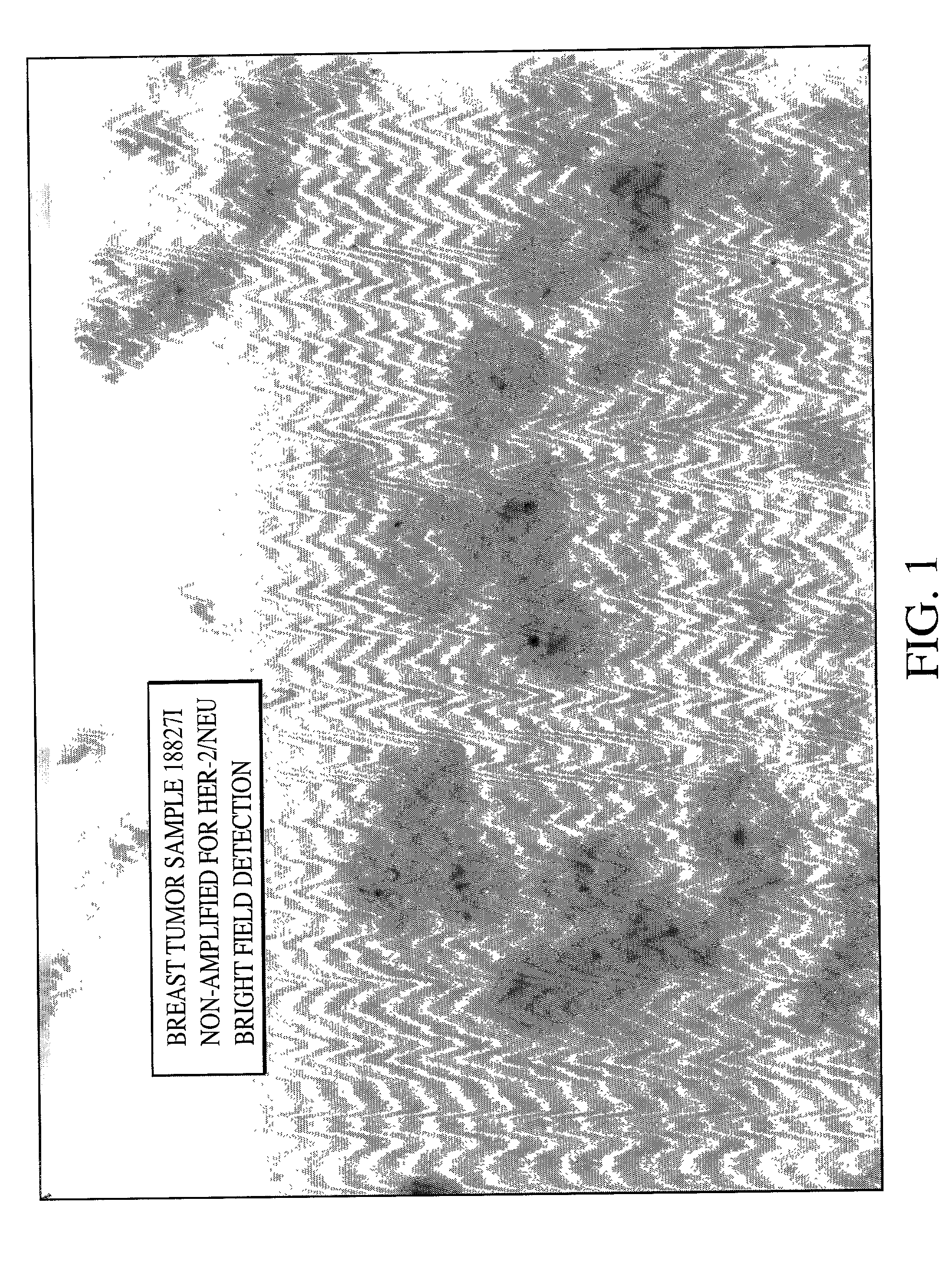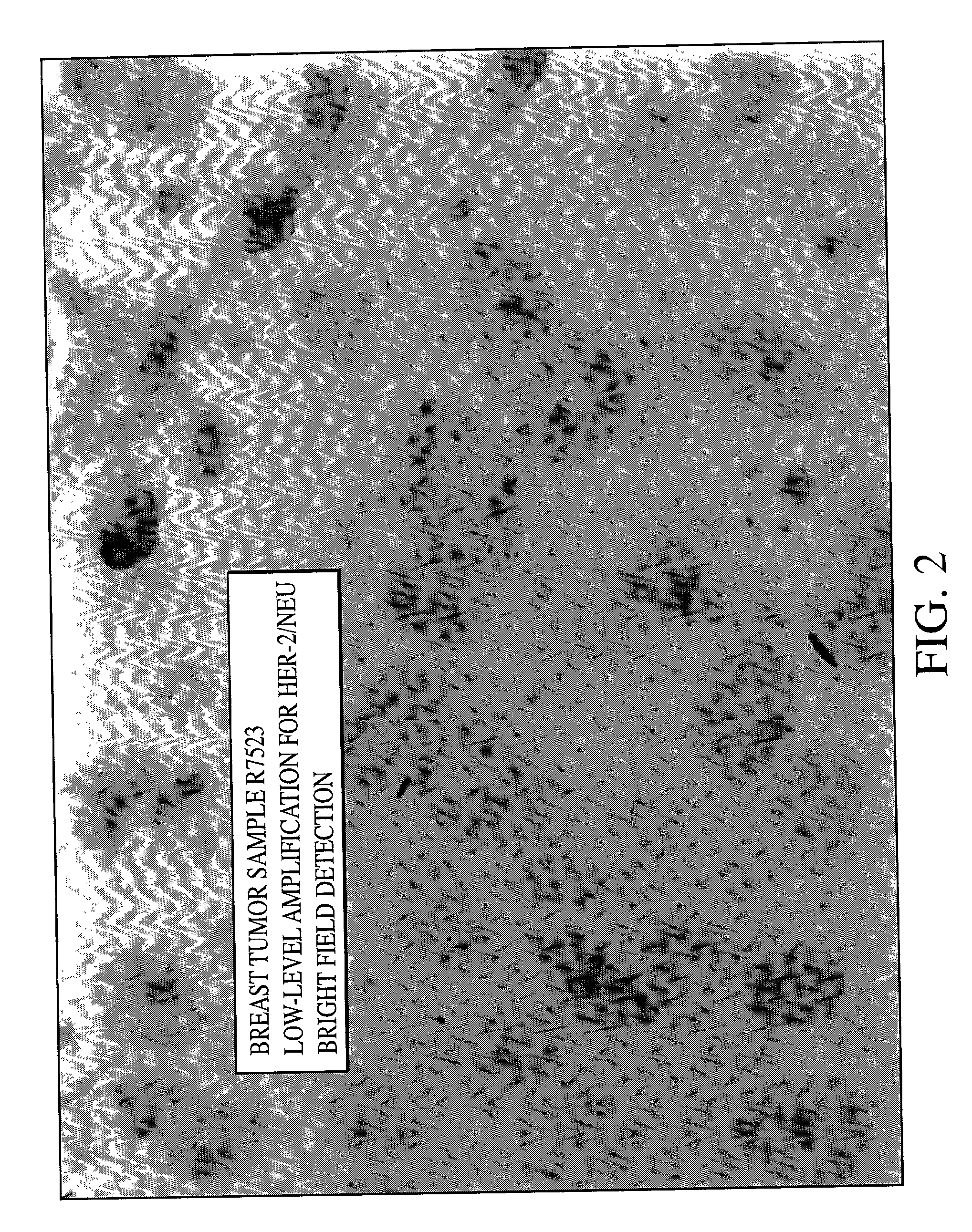Method of detecting single gene copies in-situ
a single gene and copy technology, applied in the field of nucleic acid detection and localization techniques, can solve the problems of radioactive toxicity and environmental concerns, other viral diseases are also frequently difficult to detect or distinguish clinically, and the signal generated by fluorescent markers is typically faded
- Summary
- Abstract
- Description
- Claims
- Application Information
AI Technical Summary
Problems solved by technology
Method used
Image
Examples
example 2
Detection of Single Gene Copies
[0077] The slides produced in Example 1 were mounted with Permount (Fisher Scientific, NJ) and coverslipped.
[0078] Using brightfield microscopy, microphotographs were made on Kodak Ektachrome color slide film (EL 400), using a Zeiss Axiophot 20 epi-fluorescence microscope (Zeiss, West Germany) equipped with a 100X Plan-Neofluar oil immersion objective or a 100X Plan-APO oil immersion objection (Zeiss, West Germany), a Zeiss MC-100 camera (Zeiss, West Germany), and a blue or neutral density filter.
[0079] As can be seen from FIGS. 1, 2 and 3 single blue signal was visible at the location of each copy of the HER-2 / neu gene. The expected results for visualization of the HER-2 / neu gene in normal metaphase chromosomes from the MDA-MB468 breast tumor cell line is two; one on each chromatin, and the number of the blue signals in normal interphase nuclei is also two, or possibly two pairs if the cell is in G2 phase. In the cultured breast tumor cell lines MDA-M...
example 3
Detection of High Risk Human Papilloma Virus in Gynecologic Tissue Specimen
[0080] Six separate commercially available plasmids, i.e., pGem2, pUC13, pGem1, pLINK322, pGEM1 and pUCI3 containing entire genomes of HPV types 16 (DNA sequence available from GenBank, Accession No. K02718), 18 (DNA sequence available from GenBank, Accession No. X05015), 31 (DNA sequence available from GenBank, Accession No. J04353), 33 (DNA sequence available from GenBank, Accession No. M12732), 35 (DNA sequence available from GenBank, Accession No. M74117) and 51 (DNA sequence available from GenBank, Accession No. M62877) respectively, were labeled by nick translation with digoxigenin dCTP. Alternatively, one may clone the HPV into a plasmid by standard molecular biology techniques within the skill of the art. The labeled plasmids were then mixed together to form a single reagent. Incorporation of the digoxigenin nucleotide into the labeled DNA was verified by dot-blot procedure. DNA fragment size was dete...
example 4
Automated ISH Staining and Single Gene Copy Detection
[0093] The paraffin-embedd method of Example 1 was repeated on a DISCOVERY.TM. automated slide stainer discribed in PCT / US99 / 04181 with all steps being performed automatically. Using the same reagents and conditions of Example 1, individual spots representing single gene copies were observed using the detection methods of Example 2.
PUM
 Login to View More
Login to View More Abstract
Description
Claims
Application Information
 Login to View More
Login to View More - R&D
- Intellectual Property
- Life Sciences
- Materials
- Tech Scout
- Unparalleled Data Quality
- Higher Quality Content
- 60% Fewer Hallucinations
Browse by: Latest US Patents, China's latest patents, Technical Efficacy Thesaurus, Application Domain, Technology Topic, Popular Technical Reports.
© 2025 PatSnap. All rights reserved.Legal|Privacy policy|Modern Slavery Act Transparency Statement|Sitemap|About US| Contact US: help@patsnap.com



